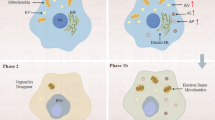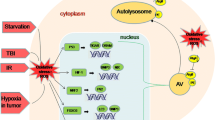Summary
Researches have shown that melatonin is neuroprotectant in ischemia/reperfusion-mediated injury. Although melatonin is known as an effective antioxidant, the mechanism of the protection cannot be explained merely by antioxidation. This study was devoted to explore other existing mechanisms by investigating whether melatonin protects ischemia/reperfusion-injured neurons through elevating autophagy, since autophagy has been frequently suggested to play a crucial role in neuron survival. To find it out, an ischemia/reperfusion model in N2a cells was established for examinations. The results showed that autophagy was significantly enhanced in N2a cells treated with melatonin at reperfusion onset following ischemia and greatly promoted cell survival, while autophagy blockage by 3-MA led to the shortened N2a cell survival as assessed by MTT, transmission electron microscopy, and laser confocal scanning microscopy. Besides, the protein levels of LC3II and Beclin1 were remarkably increased in ischemia/reperfusion-injured N2a in the presence of melatonin, whereas the expression of p-PKB, key kinase in PI3K/PKB signaling pathway, showed a decrease when compared with untreated subjects as accessed by immunoblotting. Taken together these data suggest that autophagy is possibly one of the mechanisms underlying neuroprotection of melatonin.
Similar content being viewed by others
References
Olivieri G, Brack C, Muller-Spahn, et al. Mercury induces cell cytotoxicity and oxidative stress and increases β-amyloid secretion and Tau phosphorylation in SHSY’5Y neuroblastoma cells. J Neurochem, 2000,74(1):231–236
Cheung RT. Cerebrovascular disease—advances in management. Hong Kong Med J, 2001,7(1):58–66
Chan PH. Role of oxidants in ischemic brain damage. Stroke, 1996,27(6):1124–1129
Margaill I, Plotkine M, Lerouet D. Antioxidant strategies in the treatment of stroke. Free Rad Biol Med, 2005,39(4):429–443
Lipton P. Ischemic cell death in brain neurons. Physiol Rev, 1999,79(4):1431–1568
Warner DS, Sheng H, Batinie-Haberle I. Oxidants, antioxidants and the ischemic brain. J Exp Biol, 2004,207(18): 3221–3231
Letechipía-Vallejo G, López-Loeza E, Espinoza-González V, et al. Long-term morphological and functional evaluation of the neuroprotective effects of post-ischemic treatment with melatonin in rats. J Pineal Res, 2007,42(2):138–146
Pei Z, Cheung RT. Pretreatment with melatonin exerts anti-inflammatory effects against ischemia/reperfusion injury in a rat middle cerebral artery occlusion stroke model. J Pineal Res, 2004,37(2):85–91
Watanabe K, Wakatsuki A, Shinohara K, et al. Maternally administered melatonin protects against ischemia and reperfusion-induced oxidative mitochondrial damage in premature fetal rat brain. J Pineal Res, 2004,37(4):276–280
Lipartiti M, Franceschini D, Zanoni R, et al. Neuroprotective effects of melatonin. Adv Exp Med Biol, 1996,398:315–321
Kilic E, Ozdemir YG, Bolay H, et al. Pinealectomy aggravates and melatonin administration attenuates brain damage in focal ischemia. J Cereb Blood Flow Metab, 1999,19(5):511–516
Sarrafzadeh AS, Thomale UW, Kroppenstedt SN, et al. Neuroprotective effect of melatonin on cortical impact injury in the rat. Acta Neurochir (Wien), 2000,142(11):1293–1299
Duan QH, Wang ZQ, Lu T, et al. Comparison of 6-hydroxylmelatonin or melatonin in protecting neurons against ischemia/reperfusion-mediated injury. J Pineal Res, 2006,41(4):351–357
Klionsky DJ, Emr SD. Autophagy as a regulated pathway of cellular degradation. Science, 2000,290(5497):1717–1721
Pan T, Kondo S, Zhu W, et al. Neuroprotection of rapamycin in lactacystin-induced neurodegeneration via autophagy enhancement. Neurobiol Dis, 2008,32(1):16–25
Carloni S, Buonocore G, Balduini W. Protective role of autophagy in neonatal hypoxia-ischemia induced brain injury. Neurobiol Dis, 2008,32(3):329–339
Blomgren K, Zhu CL, Hallin U, et al. Mitochondria and ischemic reperfusion damage in the adult and in the developing brain. Biochem Biophys Res Commun, 2003,304(3):551–559
Love S. Apoptosis and brain ischaemia. Prog Neuropsychopharmacol Biol Psychiatry, 2003,27(2):267–282
Kim I, Rodriguez-Enriquez S, Lemasters JJ. Selective degradation of mitochondria by mitophagy. Arch Biochem Biophys, 2007,462(2):245–253
Banasiak KJ, Xia Y, Haddad GG. Mechanisms underlying hypoxia-induced neuronal apoptosis. Prog Neurobil, 2000,62(3):215–249
Poeggeler B, Reiter RJ, Tan DX, et al. Melatonin, hydroxyl radical-mediated oxidative damage, and aging: a hypothesis. J Pineal Res, 1993,14(4):151–168
Cervantes M, Morali G, Letechipia-Vallejo G. Melatonin and ischemia-reperfusion injury of the brain. J Pineal Res, 2008,45(1):1–7
Chan PH. Role of oxidants in ischemic brain damage. Stroke, 1996,27(6): 1124–1129
Reiter RJ, Tan DX, Pappolla MA. Melatonin relieves the neural oxidative burden that contributes to dementias. Ann N Y Acad Sci, 2004,1035:179–196
Harms C, Lauternschlager M, Bergk A. Melatonin is protective in necrotic but not in caspase-dependent, free radical-independent apoptotic neuronal cell death in primary neuronal cultures. FASEB J, 2000,14(12):1814–1824
Kabeya Y, Mizushima N, Ueno T, et al. LC3, a mammalian homologue of yeast Apg8p, is localized in autophagosome membranes after processing. EMBO J, 2000,19(21):5720–5728
Mizushima, N. Methods for monitoring autophagy. Int J Biochem Cell Biol, 2004,36(12):2491–2502
Tassa A, Roux MP, Attaix D, et al. Class III Phosphoinositide 3-kinase-Beclin1 complex mediates the amino acid-dependent regulation of autophagy in C2C12 myotubes. Biochem J, 2003,376(Pt 3):577–586
Li J, Ni M, Lee B, et al. The unfolded protein response regulator GRP78/BiP is required for endoplasmic reticulum integrity and stress-induced autophagy in mammalian cells. Cell Death Differ, 2008,15(9):1460–1471
Liang XH, Jackson S, Seaman M, et al. Induction of autophagy and inhibition of tumorigenesis by beclin 1. Nature, 1999,402(6762):672–676
Potter CJ, Padraza LG, Xu T. Akt regulates growth by directly phosphorylating Tsc2. Nat Cell Biol, 2002,4(9):658–665
Manning BD, Tee AR, Logsdon MN, et al. Identification of the tuberous sclerosis complex-2 tumor suppressor gene product tuberin as a target of the phosphoinositide 3-kinase/akt pathway. Mol Cell, 2002,10(1):151–162
Inoki K, Li Y, Zhu T, et al. TSC is phosphorylated and inhibited by Akt and suppresses mTOR signaling. Nat Cell Biol, 2002,4(9):648–657
Scott RC, Schuldiner O, Neufeld TP. Role and regulation of starvation-induced autophagy in the Drosophila fat body. Dev Cell, 2004,7(2):167–178
Wullschleger S, Loewith R, Hall MN. TOR signaling in growth and metabolism. Cell, 2006,124(3):471–484
Lum JJ, DeBerardinis RJ, Thompson CB. Autophagy in metazoans: cell survival in the land of plenty. Nat Rev Mol Cell Biol, 2005,6(6):439–448
Noda T, Ohsumi YJ. Tor, a phosphatidylinositol kinase homologue, controls autophagy in yeast. J Biol Chem, 1998,273(7):3963–3966
Kabeya Y, Mizushima N, Ueno T, et al. LC3, a mammalian homologue of yeast Atg8p, is localized in autophagosome membranes after processing. EMBO J, 2000,19(21):5720–5728
Author information
Authors and Affiliations
Corresponding author
Additional information
The authors contributed equally to this wore.
This project was supported by a grant from the PhD Programs Foundation of Ministry of Education of China (No. 20070487101).
Rights and permissions
About this article
Cite this article
Guo, Y., Wang, J., Wang, Z. et al. Melatonin protects N2a against ischemia/reperfusion injury through autophagy enhancement. J. Huazhong Univ. Sci. Technol. [Med. Sci.] 30, 1–7 (2010). https://doi.org/10.1007/s11596-010-0101-9
Received:
Published:
Issue Date:
DOI: https://doi.org/10.1007/s11596-010-0101-9




